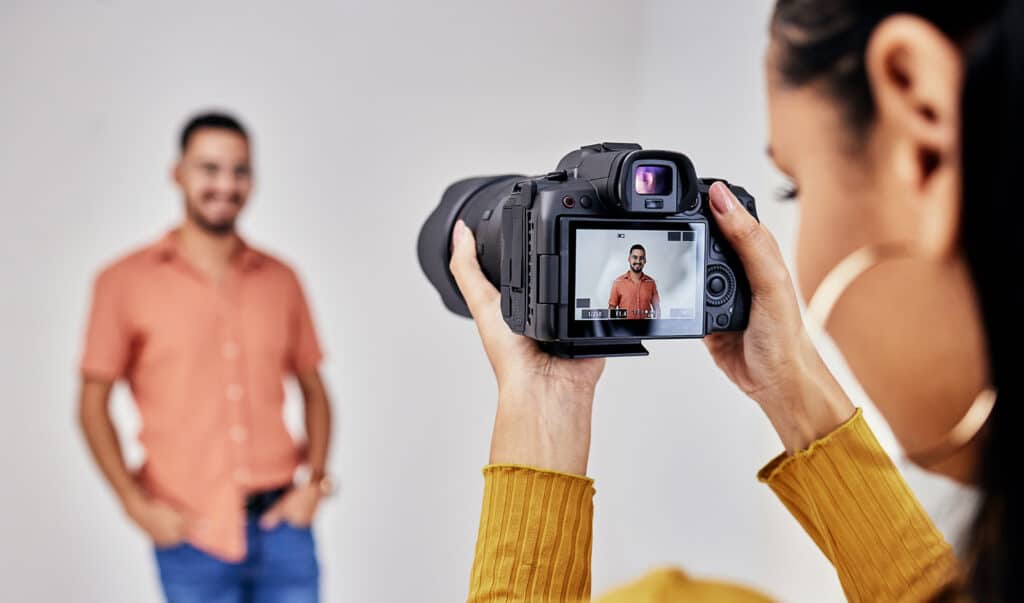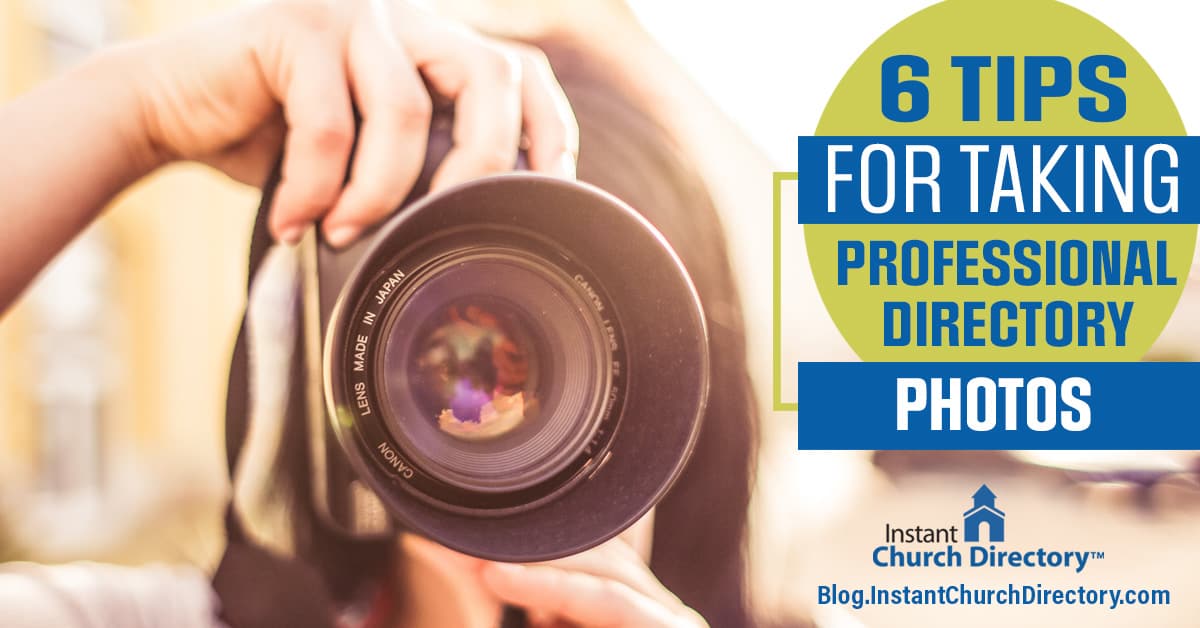One downside of creating your own church directory or using do-it-yourself church directory software is having to take your own photos of church members. None of us want to end up with a directory filled with “mug shots” that embarrass or infuriate members. After all, who of us is pleased with the photo on our driver’s license? If members don’t like their photos, they’ll resist your church directory no matter how useful it is.
Getting good quality and updated photos for your church directory can seem like a daunting and (possibly) expensive project. Thankfully, most of us carry a camera with us every day that’s capable of taking high-quality photos that work great for a church directory.
Photography has much more to do with the person holding the camera than with the machine resting in his or her hands. You can take sharp pictures with a simple point-and-shoot digital camera, and you can get lousy pictures from the most expensive Nikon. With just a little know-how, you can take beautiful member images that make everyone happy.
We’ve compiled a list of tips and tricks to help you maximize your church directory photoshoot.
Tip #1: Plan it out and practice.
Look for uncomplicated backgrounds that don’t distract from the smiling faces. Be aware of clutter and unnecessary objects when framing your shot. Using backgrounds such as Christmas trees or “holiday” themed backgrounds can also make your church directory feel dated in July, so keep your background simple.
Before taking any photos, it’s important to plan out your photoshoot and decide what, who, when and where. Make sure you give your members lots of reminders about when the photoshoot will be. If you have a large membership to photograph, consider either multiple dates or multiple photographers so no one must wait too long.
It’s a good idea to practice your setup before you start the official photoshoot to make sure you’re happy with the results. Multiple family photoshoots can be hectic and overwhelming, so spending some time practicing beforehand can mean the difference between stellar results or poor results. It’s also a good idea to have a few volunteers who can help manage families and keep everything in order.
Tip #2: Keep it simple with distraction-free backgrounds.
Choosing the right background can make all the difference in your church directory photos.
Look for uncomplicated backgrounds that don’t distract from the smiling faces. Be aware of clutter and unnecessary objects when framing your shot. Using backgrounds such as Christmas trees or holiday-themed backgrounds can also make your church directory feel dated in July, so keep the background simple.
Try to find distraction-free, neutral-colored areas to take the photos. Avoid backgrounds that might be brighter than the foreground subjects, as well as bright color backgrounds that might clash with your member’s outfits. Brick walls, long open hallways, or porticos make great choices.
If you’re shooting against a plain background, then try to have your subjects a few feet off the wall to avoid that mugshot look.

Tip #3: Good lighting is key.
Good quality and consistent lighting are the keys to strong photo directory images. Whenever possible, use natural light when taking your church photos. Natural light makes a big difference in your photos but be sure to avoid harsh direct light. Instead, opt for larger, diffused light sources or covered outdoor spaces like patios or porches. Remember to have the subjects face any light source.
If the weather allows you to take the photos outside, these are often some of the best images. Look around for a background that has some natural, green grass. Or just use the side of your church to create a unique background (for free!). Find a shady spot and have the individual or family face toward the light. It’s best to avoid dappled light, such as under trees, as the camera will struggle to pick up the light and dark areas of the photo. Have people stand as close to the edge of the shadow as you can, but with all faces still within the shade. Overcast days are some of the best times to take photos outside, creating a soft, natural light on your members’ faces.
If inside, try using a window or door light to illuminate the family. Have people FACE the window or door and then take the photo with your back to the door. If you need to use a flash, make sure the family is at least 10 feet from the background so you don’t cast a shadow on whatever is behind them. An inexpensive ring light or portable light source is relatively inexpensive these days and can also create effective lighting.
Even professional photographers take more than one shot. They change the exposures and angles to ensure they get the shot they want. The beauty of digital photography is that you can keep shooting until you get the perfect shot and then delete the photos you don’t like. This is especially important for family shots, to ensure you get a photo with everyone’s eyes open.
Tip #4: Prepare your tools.
Don’t take the chance of missing a wonderful photo because the memory card in your camera is full. This is essential if you’re shooting high-resolution images. Pack an extra memory card with you – even if you think you won’t need it. This goes for power cords and batteries too. Better to have them and not need them, than to need them and have to take photos on another occasion.
Before taking any photos, it’s important to check that there are no smudges or dust on your camera lens. A greasy smudge can lead to that soft, out-of-focus halo effect that went out of style in the 1970s. Because our hands are often close to the lens, it’s very easy to inadvertently touch it. So remember to check for smudges periodically.

Tip #5: Aim for consistency.
Keeping the variables consistent helps create a cohesive look in your church directory photos. Have your subjects all stand in the same area, and try to take the photos from the same place as well.
Consider using a tripod to ensure consistent photos. Or stand on a stepladder so the subjects are all looking slightly upward towards the camera. Tripods are a great way to stay consistent when taking multiple member photos. This makes it easy for you to know exactly where members need to stand without having to refocus or reposition your camera. It also makes the whole process faster for members. Using a tripod allows you to move out from behind the camera to grab a little kid’s attention or give a big goofy smile to make members smile back at you. When you don’t have a tripod handy, set the camera on a table, fence post or other flat, stable surface. A tripod also helps with eliminating blurry photos from camera shakes when you are taking photos inside with low or no natural light. Using a tripod or stepladder can also make sure the photo crop is the same. On that subject, decide beforehand what style of portrait photo will work best for your directory. A full-body portrait is a good idea for families so no awkward cropping issues arise with shorter members. Make sure to leave some breathing room above the heads and below the feet of your subjects to avoid unpleasant cropping.
If multiple volunteers are taking photos, try to make sure they’re all using the same brand of mobile phone. That will keep the look of the photos consistent. For more in-depth details about setting up your camera or the best angles for fantastic photos, check out a few of these videos from professionals: 14 tips to help you take better family photos with your smartphone.
Tip #6: Help your members relax.
Some of the most outstanding photos will result from members being relaxed and showing their natural smiles. The best way to do this is to talk and joke with people while taking their photos. Encourage them to take a deep breath, close their eyes, then open their eyes and smile. You can also take a few “just test shots” to help members who tend to stiffen up in front of the camera lens.
Some of the finest directories have informal pictures of the members with various backgrounds. Think of photos with the child making a funny face and the adults all laughing. The members are relaxed. Those snapshots make people think, “I’d want to go to church there” because the members look happy to be part of this group.
Your members may be sensitive to their photos being posted online. So it’s always a good idea to set their expectations and get their consent for the specific use of the photos. This is especially true if the photos may be used beyond the directory on your social media platforms or website.
We hope this guide helps build the confidence you need to update your church member photo directory!
